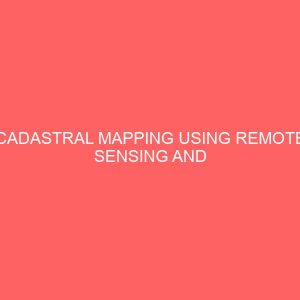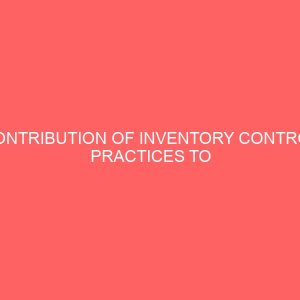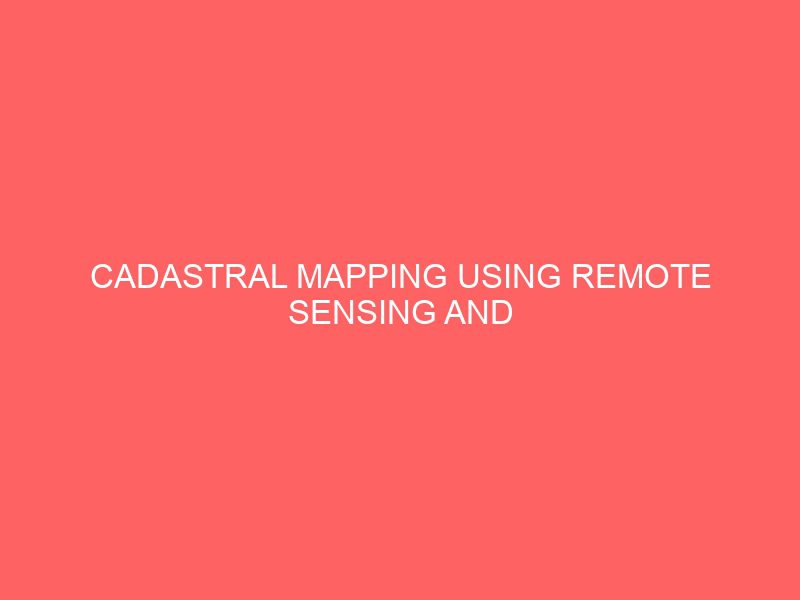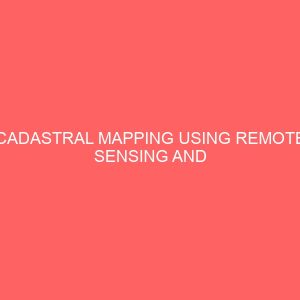Description
Banjiram is one of the communities resettled in the year 1980 to make room for the construction of Kiri dam to supply the Savannah Sugar Company with water for Irrigation. As part of the resettlement program, the Federal Government then, cleared and surveyed an alternative location now New Banjiram. A cadastral survey was carried out and plots were physically delineated on the ground with beacons at the corners of each plot. Land right were orally transmitted and the evidence of such land rights has been based on the knowledge of community elders and village chiefs. With increasing population and consequent competition for land, there has been prevailing tenure insecurity with its associated conflicts and litigations over land ownership. One of the most important documents: paperbased cadastral layout of the area containing delineated parcels has been lying the cabinet of the Adamawa state Ministry of Lands and Survey in a decaying state. This research is aimed at carrying out a cadastral mapping of Banjirm using Remote Sensing and GIS with a view to developing digital cadastral Information System which has the ability to integrate the map and the record of ownership and use. To achieve this, the cadastral layout of the study area was scanned and georeferenced in ArcGIS 10.1. Parcels were then digitally delineated digitized and given unique identification numbers. To obtain the textual component of the cadastre land ownership and use information, a fieldwork was carried out to determine the existing land rights through a participatory process of adjudication. The adjudication involved visits to each parcel by a team comprising the researcher, a representative of the traditional heads and member of the Land owners union. To ease the process, a remotelysensed imagery Google Earth image upon which the digitized parcels with unique numbers was overlaid was presented to land owners and witnesses adjoining land owners to visually identify their parcels and present their claims. A questionnaire adjudication form was used to record information on land owners and their parcels. A digital camera was also used to capture the passport photograph of each land owner. After the fieldwork, a cadastral database containing the digital record of land owners and their parcels was then designed and built using the information gathered. Analysis and testing of the efficiency of the database was then performed and a variety of results were generated. Major findings of this research include: i there were 1278 parcel with 1166 owner; ii about 1086 84.977 parcels were allocated while192 15.023 parcels were not allocated; iii there were 865 67.762 parcels that were developed while 413 32.238 parcels were not developed; iv out of the 1278 parcels: 758 31.91 were found to be used for residential purpose; 32 20.016 for institutional purpose; 11 2.431 for commercial purpose; 158 14.2 for agricultural purpose and 301 31.408 for mixed uses.
1.1 BACKGROUND TO THE STUDY
Land is a great resource and indeed, the backbone of wealth in many communities, whether urban or rural. People have depended on land for food, shelter, employment, resource, cultural and religious needs. Land is the foundation of all human activity. The relationship of people to land is fundamental to human existence United Nations Economic Commission for Europe UNECE, 2005. Issues of land have been identified to be a cause of civil and international wars and even genocide Bell, 2011. Conflicts over ownership, land grabs, social disharmony, reductions in yields, diminished food security, weak land markets and negative impacts on the environment are associated with regions with poor system of land information management McLaren, 2011. Current and reliable land information in terms of ownership, land use and value is necessary for: ensuring the security of property rights; reduction in litigation and less work for the courts; better land assessment and taxation; better information base for planning and administration; improving map production such as base map, utility asset maps, zone maps and so on; easier transactions in land; establishing a transparent and operational land market; less corruption in land affairs and update the land information Kabir, 2009. The cadastre is the core component of land information management Andersson, 1986.
The International Federation of Surveyors FIG, 1995 defines a cadastre as a parcel based and uptodate land information system containing a record of interests in land e.g. rights, restrictions and responsibilities. Williamson Ting 1999 identified three forms of cadastre: the fiscal cadastre used for generating revenue through taxation; legal or judicial cadastre used for protecting property ownership rights and; multipurpose cadastre combining both functions of the fiscal and legal cadastres as well as being used for utility management, planning, environmental management, etc.. The core component of cadastres, Cadastral information system or Land Information System is the cadastral map obtained through cadastral mapping.
Synonymous with cadastre and cadastral mapping is land registration. According to McLaughlin Nichols 1989 land registration is process of recording legally recognized interests in land. The overall aim of land registration is building a cadastre Jing, 2011. Crucial to land registration is adjudication. The term adjudication was first used in 1950s to describe systematic ascertainment of rights in land Lawrence, 1985. Adjudication is the first stage of land registration aimed at formalizing land through the procedure of land rights identification, demarcation cadastral surveying and mapping Dale and McLaughlin, 1999. Adjudication occurs in two cases where no earlier register information is available or where the old information becomes obsolete with very bad quality Jing, 2011.Cadastral mapping could be described as the process and methods of building of information on land. Traditionally, cadastres and cadastral mapping systems have been manual and paperbased Borzacchiello Craglia, 2012. They contained a numerical/diagrammatic description a graphical description of land parcels and a separate list of land register containing a list of names and rights of land holder Zevenbergen, 2002. Indexing schemes were used to link the map and the register.
Recent developments in the Remote Sensing and Geographic Information System GIS and webbased GIS, internet communications, band width and transmission speeds have necessitated and made possible the development of digital cadastres and cadastral mapping systems allowing the map and the register to be integrated into one single system a digital cadastral map database Sutherland Nichols, 2002. With the development of Geoinformation technologies GIT adjudication of land rights benefits greatly from the use of Remote Sensing/Photogrammetry Jing, 2011. Remotelysensed georeferenced orthophotos have been used for adjudication in various regions of the world Meijs, Kapintango Witmer 2009. Remote Sensing and Geographic information systems GIS have therefore become important geometric tools for building of digital cadastral systems Albert, Edmund, Merem Yaw, 2006. Elayachi Semlali 2001 noted that a digital cadastral map is not a map in the traditional sense, but a map in which attributes tabular and map graphic data on cadastral unit are stored in the same database. They added that a digital cadastral map registers each parcel and its owners and describes all the spatial structures consisting of location, boundaries and contents.
While Western nations are advancing in the creation of multipurpose cadastres that are aimed at supporting sustainable development, developing countries are only recently starting to establish more formal cadastral records for fiscal or other purpose.
In Nigerian, cadastral mapping land/registration and administration suffer from among others lack of use of appropriate technology in surveying and the mapping industry. Cadastral maps are worn out and outdated and modernization efforts are only made for urban lands and are still on pilot basis Oboli Akpoyoware, 2010. Only a few states including Lagos, Kano and the Federal Capital Territory have computerized land information Bell, 2011. A greater part of land in Northern Nigeria is held under a customary system without being covered by cadastral mapping and land title registration Usman, 2010.








Reviews
There are no reviews yet.